Tamborim
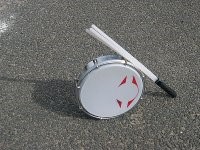 The Tamborim (“Tam”) is the smallest of the drums. They’re not the same ast those tambourines with bells that you played at school. In samba, tams have no bells, and are hit with sticks made up of multiple flexible rods or prongs to produce a loud, sharp high-pitched “crack”. The tamborim is a very common Brazilian instrument. In the samba it’s used to mark points that rock, so they are a good instruments to start playing samba and getting to know the tunes.
The Tamborim (“Tam”) is the smallest of the drums. They’re not the same ast those tambourines with bells that you played at school. In samba, tams have no bells, and are hit with sticks made up of multiple flexible rods or prongs to produce a loud, sharp high-pitched “crack”. The tamborim is a very common Brazilian instrument. In the samba it’s used to mark points that rock, so they are a good instruments to start playing samba and getting to know the tunes.
Agogô
 Agogô means “bell” and it’s probably the oldest of the samba instruments. It’s originated in Africa and holds a highly ritually meaning in the Candomblé (where most of the samba-rhythms come from) which was performed mostly by people brought to South America as abducted slaves. The agogô is made up of at least two small cow bells joined together. It is being hit with one wooden stick and it’s like the only “melodic” instrument.
Agogô means “bell” and it’s probably the oldest of the samba instruments. It’s originated in Africa and holds a highly ritually meaning in the Candomblé (where most of the samba-rhythms come from) which was performed mostly by people brought to South America as abducted slaves. The agogô is made up of at least two small cow bells joined together. It is being hit with one wooden stick and it’s like the only “melodic” instrument.
Shaker
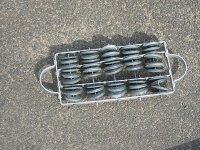 With its constant rattling, the shaker (also called chocalho) fills up the tune and give samba music its distinctive sound. It might look easy to play but it requires a good technique and lot of stamina! The two most common shaker types are the rocar and the ganzá. The rocar is made up of lots of small metal disks attached to a stick. They sound like Santa on a joyride. A ganzá is a cylindrical metal tube filled with beads or metal balls to create a lovely swishy sound. Ganzás tend to be more quiet than rocars. In traditional samba bands the chocalhos form a kind of sound-layer, which accompanies the samba. After breaks they often take a small break, coming into the tune a bit later than the other instruments – completing the tune and bringing some kind of “awe”-moment. In RoR-tunes and RoR-practice their role (of forming the sound layer, that the tune is based on) is done by the snares.
With its constant rattling, the shaker (also called chocalho) fills up the tune and give samba music its distinctive sound. It might look easy to play but it requires a good technique and lot of stamina! The two most common shaker types are the rocar and the ganzá. The rocar is made up of lots of small metal disks attached to a stick. They sound like Santa on a joyride. A ganzá is a cylindrical metal tube filled with beads or metal balls to create a lovely swishy sound. Ganzás tend to be more quiet than rocars. In traditional samba bands the chocalhos form a kind of sound-layer, which accompanies the samba. After breaks they often take a small break, coming into the tune a bit later than the other instruments – completing the tune and bringing some kind of “awe”-moment. In RoR-tunes and RoR-practice their role (of forming the sound layer, that the tune is based on) is done by the snares.
Repinique
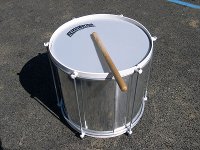 The Repinique (pronounced Rep-a-nee-key) or “hep” or “repi” looks more like a „proper“ drum and produces a sound similar but more mellow and tonal to the tamborim. It is usually the repi and tams that produce the “tune”. In RoR tunes, there are four different hits that can be performed on a repinique. Some call-response breaks start with the repinique calling, so make sure you get your entry.
The Repinique (pronounced Rep-a-nee-key) or “hep” or “repi” looks more like a „proper“ drum and produces a sound similar but more mellow and tonal to the tamborim. It is usually the repi and tams that produce the “tune”. In RoR tunes, there are four different hits that can be performed on a repinique. Some call-response breaks start with the repinique calling, so make sure you get your entry.
Caixa / Snare
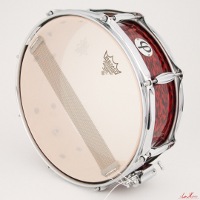 The Caixa (ca-sha) or snare drum is one of the most difficult to master, but provides the essential feeling of movement to the rhythms. The actual caixa is a bit smaller than the snare, but thicker. The snare of the caixa is – unlike the one of a snare drum – not made by a bunch of spirals on the resonant head, but by guitar-like strings tightened to the batter. A snare is rather comparable to marching band snares, while we use drum-kit snares because they do the same job 😉 Once you get both of your sticks rebounding everything is flowing. If you never played it before it would be good to practise your motoric skills for some time, until you manage to play the fast notes evenly with both sticks.
The Caixa (ca-sha) or snare drum is one of the most difficult to master, but provides the essential feeling of movement to the rhythms. The actual caixa is a bit smaller than the snare, but thicker. The snare of the caixa is – unlike the one of a snare drum – not made by a bunch of spirals on the resonant head, but by guitar-like strings tightened to the batter. A snare is rather comparable to marching band snares, while we use drum-kit snares because they do the same job 😉 Once you get both of your sticks rebounding everything is flowing. If you never played it before it would be good to practise your motoric skills for some time, until you manage to play the fast notes evenly with both sticks.
Surdos
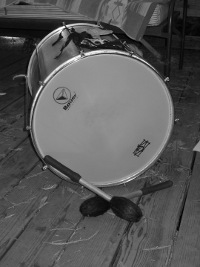 The Surdos are the large bass drums in the band. They come in three tones, also called low (1), mid (2) and high (3). They create the underlying beat and rhythm of the music. The Surdos look simple to play, but as they are important to provide the tempo, they are a lot harder than they look.
The Surdos are the large bass drums in the band. They come in three tones, also called low (1), mid (2) and high (3). They create the underlying beat and rhythm of the music. The Surdos look simple to play, but as they are important to provide the tempo, they are a lot harder than they look.